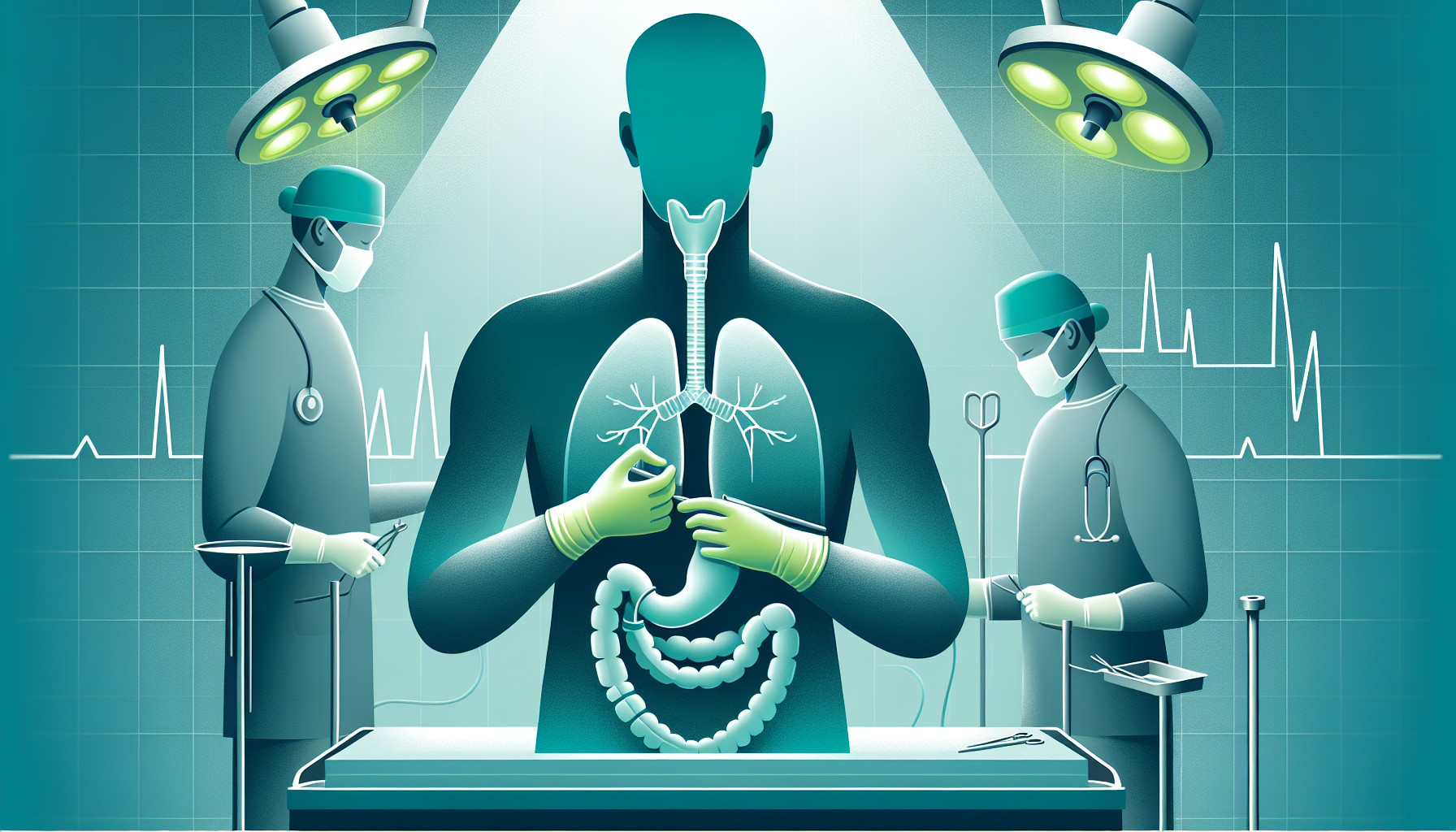Our Summary
This research paper discusses a new surgical technique for treating certain types of esophageal tumors. The technique, called hand-sewn esophago-gastric anastomosis in the prone position, involves a minimally invasive procedure that is performed with the patient lying on their stomach. It is part of a two-step procedure known as a totally minimally invasive esophagectomy.
The researchers looked at data from 150 patients who had this surgery over a five-year period. They found that the average surgery time was 320 minutes, and it took about 45 minutes to construct the connection between the esophagus and stomach (anastomosis). There were no cases where they had to switch to a traditional, open surgery.
The complication rates from the surgery were relatively low: about 2% of patients experienced a leak at the surgical site, about 7% developed a narrowing of the surgical site, and about 18% experienced respiratory complications. Cardiac complications occurred in about 7% of patients, and the rates of death within 30 and 90 days of surgery were 1.33% and 2.66%, respectively.
The authors conclude that this new surgical technique has shown promise in reducing complications related to the surgical connection in the esophagus, compared to other techniques. However, they suggest more research is needed to confirm these findings and potentially change the preferred surgical method for these types of tumors.
FAQs
- What is the hand-sewn esophago-gastric anastomosis in the prone position technique?
- What were the complication rates from the hand-sewn esophago-gastric anastomosis in the prone position?
- What were the conclusions of the research on the new surgical technique for treating esophageal tumors?
Doctor’s Tip
A doctor might tell a patient undergoing an esophagectomy to follow their post-operative care instructions closely, including taking prescribed medications, attending all follow-up appointments, and following a specific diet plan. They may also advise the patient to avoid heavy lifting and strenuous activity for a period of time to allow for proper healing. Additionally, the doctor may recommend seeking support from a nutritionist or counselor to address any dietary or emotional challenges that may arise during recovery.
Suitable For
Patients who are typically recommended esophagectomy include those with esophageal cancer, particularly those with locally advanced disease that has not spread beyond the esophagus. Other conditions that may warrant esophagectomy include Barrett’s esophagus with high-grade dysplasia, esophageal strictures that are not responsive to other treatments, and certain benign tumors of the esophagus.
Patients who are generally healthy enough to undergo major surgery and tolerate the potential risks and complications associated with esophagectomy are also considered for this procedure. Additionally, patients who have failed to respond to other treatments or have a high likelihood of recurrence may be candidates for esophagectomy.
It is important for patients to discuss the potential benefits and risks of esophagectomy with their healthcare team to determine if this procedure is the best treatment option for their specific condition.
Timeline
Before esophagectomy:
- Patient undergoes various diagnostic tests such as endoscopy, biopsy, CT scans, and PET scans to diagnose the esophageal tumor.
- Patient may undergo chemotherapy and/or radiation therapy to shrink the tumor before surgery.
- Patient receives pre-operative counseling and instructions on how to prepare for the surgery, including dietary restrictions and medication adjustments.
After esophagectomy:
- Patient undergoes surgery to remove the esophageal tumor, typically lasting around 5-6 hours.
- Patient is closely monitored in the intensive care unit (ICU) post-surgery to manage pain, monitor for complications, and ensure proper healing.
- Patient may experience difficulty swallowing and require a feeding tube for nutrition.
- Patient undergoes physical therapy and rehabilitation to regain strength and mobility after surgery.
- Patient is closely monitored for potential complications such as leaks at the surgical site, narrowing of the connection between the esophagus and stomach, respiratory complications, and cardiac complications.
- Patient may experience long-term changes in their diet and eating habits, as well as potential side effects such as reflux, dumping syndrome, and weight loss.
- Patient undergoes regular follow-up appointments and monitoring to ensure proper healing and to address any long-term complications or concerns.
What to Ask Your Doctor
- What is the purpose of an esophagectomy and why is it being recommended for me?
- What are the potential risks and complications associated with the surgery?
- How long is the recovery process expected to be and what can I do to help facilitate my recovery?
- Are there any alternative treatment options available for my condition?
- What is the success rate of this new surgical technique compared to traditional methods?
- How many procedures of this type have you performed and what is your experience with this specific technique?
- Will I need any additional treatments or therapies following the surgery?
- How will my diet and eating habits be affected after the surgery?
- What steps can I take to minimize the risk of complications during and after the surgery?
- Are there any specific lifestyle changes or precautions I should take in the long term after the surgery?
Reference
Authors: Charalabopoulos A, Davakis S, Sakarellos P, Mpaili E, Sarlani E, Sakellariou S, Ziogas D, Theochari M, Liakakos T. Journal: Anticancer Res. 2023 Jun;43(6):2749-2755. doi: 10.21873/anticanres.16442. PMID: 37247891
